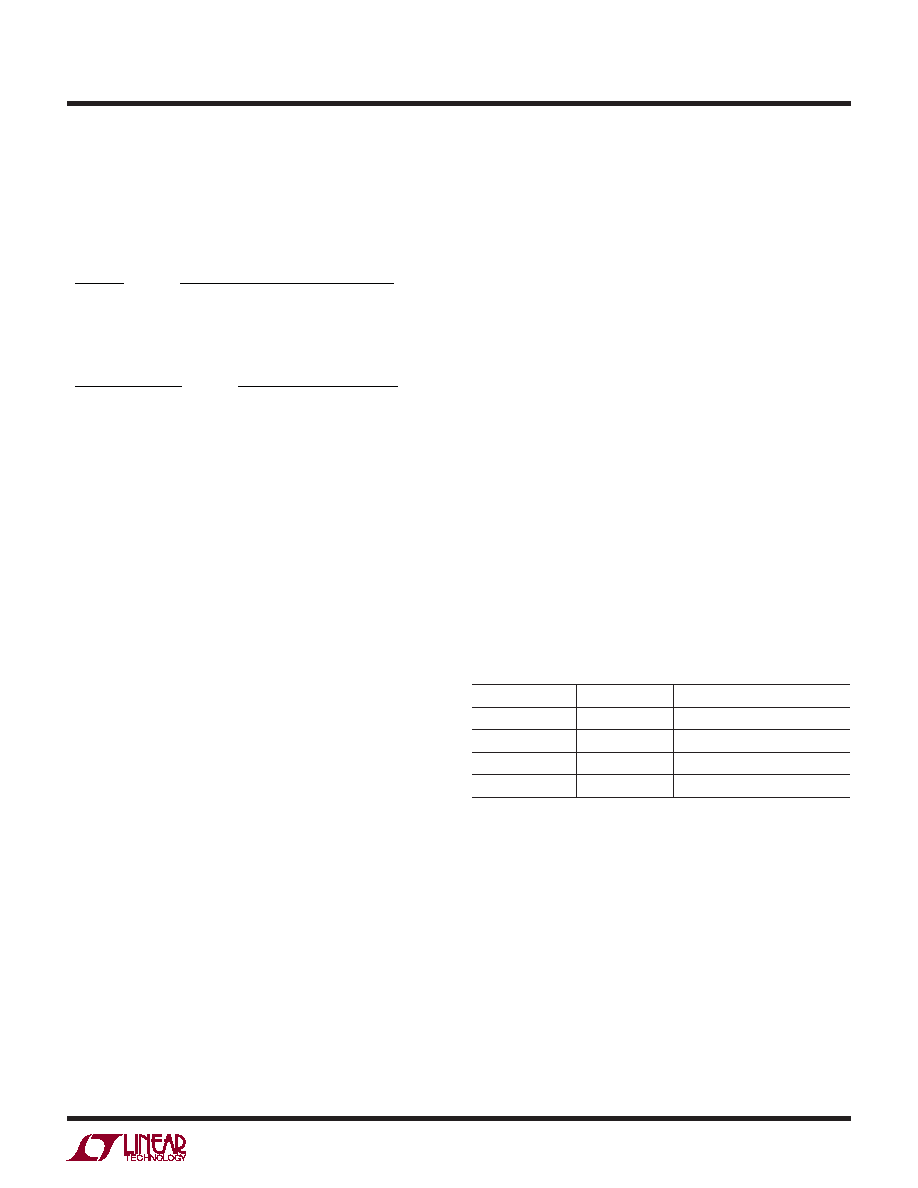- 您現(xiàn)在的位置:買賣IC網(wǎng) > PDF目錄44985 > LT3582EUD-5#TRPBF (LINEAR TECHNOLOGY CORP) 0.72 A SWITCHING REGULATOR, PQCC16 PDF資料下載
參數(shù)資料
| 型號: | LT3582EUD-5#TRPBF |
| 廠商: | LINEAR TECHNOLOGY CORP |
| 元件分類: | 穩(wěn)壓器 |
| 英文描述: | 0.72 A SWITCHING REGULATOR, PQCC16 |
| 封裝: | 3 X 3 MM, LEAD FREE, PLASTIC, MO-220WEED-2, QFN-16 |
| 文件頁數(shù): | 11/28頁 |
| 文件大?。?/td> | 315K |
| 代理商: | LT3582EUD-5#TRPBF |
第1頁第2頁第3頁第4頁第5頁第6頁第7頁第8頁第9頁第10頁當(dāng)前第11頁第12頁第13頁第14頁第15頁第16頁第17頁第18頁第19頁第20頁第21頁第22頁第23頁第24頁第25頁第26頁第27頁第28頁

LT3582/LT3582-5/LT3582-12
19
3582512fb
Maximum Load Currents: Use one of the following equa-
tions to estimate the maximum output load current for the
positive and negative output voltages:
I
OUTP =
V
IN(MIN)
V
OUTP
IPK –
T
OFF _ MIN (VOUTP + 0.5 – VIN(MIN))
2 L
0.8η
or I
OUTN =
V
IN(MIN)
V
IN(MIN)+ |VOUTN |
IPK –
T
OFF _ MIN (| VOUTN | +0.5)
2 L
0.8η
where:
VOUT
= Regulation voltage
VIN(MIN) = Minimum input voltage.
IPK
= Peak inductor current. See the
Peak
Current Rating section. Use minimum
ILIMIT rating for these calculations.
η
= Power conversion efciency (about 88%
for Boost or 78% for Inverting)
TOFF_MIN= Minimum switch off time. Typically 100ns
for Boost and 125ns for Inverting.
IOUT
= Output load current
For example, if VOUTP = 10V, VOUTN = –10V, VIN = 5V, and
L = 4.7μH then IOUTP = 117mA and IOUTN = 105mA.
Note: The 155mA (Typ) current limit of the output dis-
connect PMOS (see Electrical Characteristics) may limit
maximum IOUTP unless CAPP is shorted to VOUTP. See the
Improving Boost Converter Efciency section.
Maximum Slew Rate: Lower inductance causes higher
current slew rates which can lead to current limit over-
shoot. Choose an inductance higher than LMIN to limit
the overshoot:
LMIN = VIN(MAX) 0.2μH
where VIN(MAX) is the maximum input voltage. Using the
previous example VIN = 3V, LMIN = 0.6μH.
Capacitor Selection
The small size and low ESR of ceramic capacitors makes
them suitable for most LT3582 series applications. X5R
and X7R types are recommended because they retain their
capacitance over wider voltage and temperature ranges
than other types such as Y5V or Z5U. A 4.7μF input capaci-
tor and a 2.2μF to 10μF output capacitor are sufcient for
most LT3582 series applications. Always use a capacitor
with a sufcient voltage rating. Many capacitors rated at
2.2μF to 10μF, particularly 0805 or 0603 case sizes, have
greatly reduced capacitance at the desired output voltage.
Generally a 1206 capacitor will be adequate. A 0.22μF to
1μF capacitor placed on the CAPP node is recommended
to lter the inductor current while the larger 2.2μF to 10μF
placed on the VOUTP and VOUTN nodes will give excellent
transient response and stability. Avoid placing large value
capacitors (generally > 6.8μF) on both CAPP and VOUTP.
This conguration can be less stable since it creates two
poles, one at the CAPP pin and the other at the VOUTP
pin, which can be near each other in frequency. Table 4
shows a list of several capacitor manufacturers. Consult
the manufacturers for more detailed information and for
their entire selection of related parts.
Table 4. Ceramic Capacitor Manufacturers
MANUFACTURER
PHONE
URL
Kemet
408-986-0424
www.kemet.com
Murata
814-237-1431
www.murata.com
Taiyo Yuden
408-573-4150
www.t-yuden.com
TDK
847-803-6100
www.tdk.com
Diode Selection
Schottky diodes, with their low forward voltage drops and
fast switching speeds, are recommended for use with the
LT3582 series. The Diodes Inc. B0540WS is a very good
choice in a small SOD-323 package. This diode is rated to
handle an average forward current of 500mA and performs
well across a wide temperature range. Schottky diodes
with very low forward voltage drops are also available.
These diodes may improve efciency at moderate and cold
temperatures, but will likely reduce efciency at higher
temperatures due to excessive reverse leakage currents.
APPLICATIONS INFORMATION
相關(guān)PDF資料 |
PDF描述 |
|---|---|
| LT3582EUD#TRPBF | 0.72 A SWITCHING REGULATOR, PQCC16 |
| LT3582EUD-12#TRPBF | 0.72 A SWITCHING REGULATOR, PQCC16 |
| LT3582EUD#PBF | 0.72 A SWITCHING REGULATOR, PQCC16 |
| LT3640EFE#TRPBF | 3.4 A DUAL SWITCHING CONTROLLER, 2350 kHz SWITCHING FREQ-MAX, PDSO28 |
| LT3640IFE#TRPBF | 3.4 A DUAL SWITCHING CONTROLLER, 2350 kHz SWITCHING FREQ-MAX, PDSO28 |
相關(guān)代理商/技術(shù)參數(shù) |
參數(shù)描述 |
|---|---|
| LT3582EUDPBF | 制造商:LINER 制造商全稱:Linear Technology 功能描述:I2C Programmable Boost and Single Inductor Inverting DC/DC Converters with OTP |
| LT3582EUDTRPBF | 制造商:LINER 制造商全稱:Linear Technology 功能描述:I2C Programmable Boost and Single Inductor Inverting DC/DC Converters with OTP |
| LT3585-0 | 制造商:LINER 制造商全稱:Linear Technology 功能描述:Photofl ash Chargers with Adjustable Input Current and IGBT Drivers |
| LT3585EDDB-0 | 制造商:LINER 制造商全稱:Linear Technology 功能描述:Photofl ash Chargers with Adjustable Input Current and IGBT Drivers |
| LT3585EDDB-0#TRPBF | 功能描述:IC CHARGER PHOTOFLASH 10-DFN RoHS:是 類別:集成電路 (IC) >> PMIC - 電源管理 - 專用 系列:- 標(biāo)準(zhǔn)包裝:1 系列:- 應(yīng)用:手持/移動設(shè)備 電流 - 電源:- 電源電壓:3 V ~ 5.5 V 工作溫度:-40°C ~ 85°C 安裝類型:表面貼裝 封裝/外殼:14-WFDFN 裸露焊盤 供應(yīng)商設(shè)備封裝:14-LLP-EP(4x4) 包裝:Digi-Reel® 配用:LP3905SD-30EV-ND - BOARD EVALUATION LP3905SD-30 其它名稱:LP3905SD-30DKR |
發(fā)布緊急采購,3分鐘左右您將得到回復(fù)。